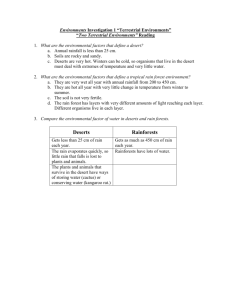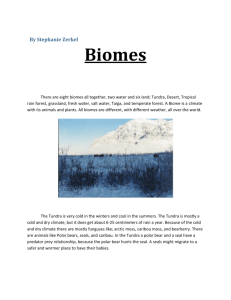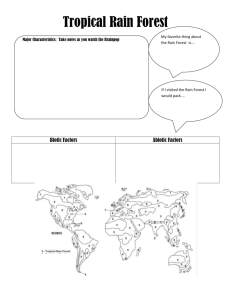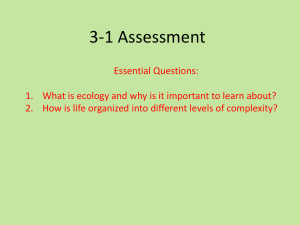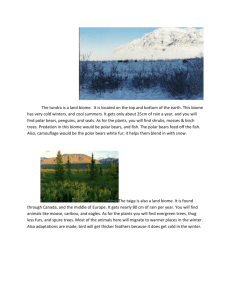Tropical Rain Forest Carolina Merkt Johana Puerta Tatiana Riera
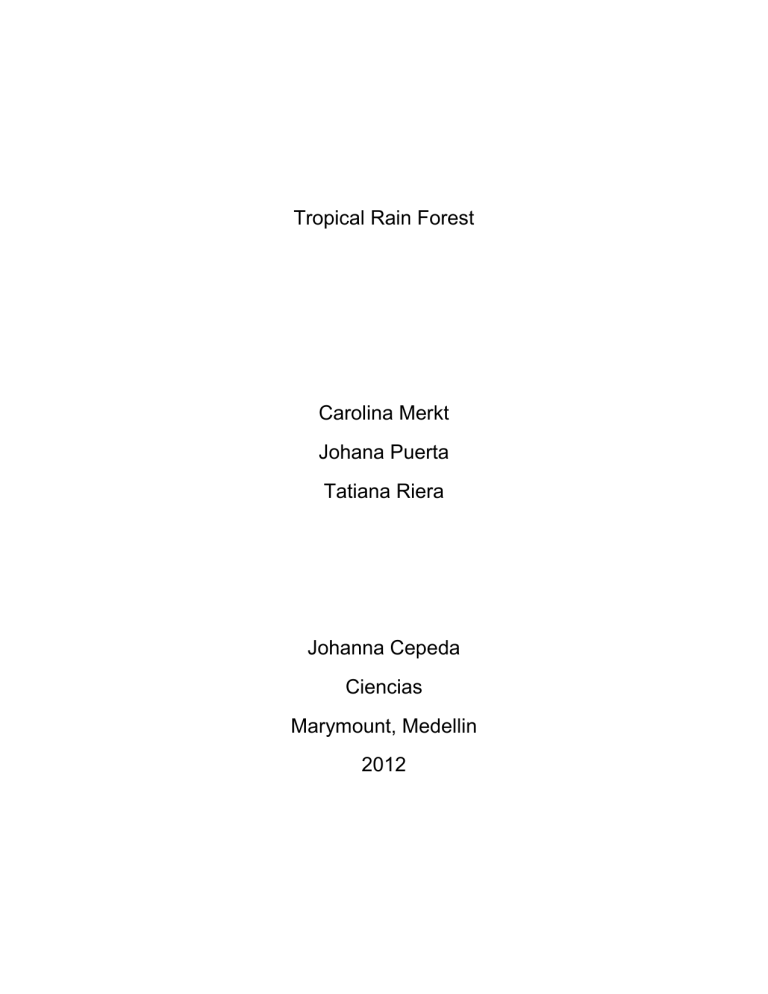
Tropical Rain Forest
Carolina Merkt
Johana Puerta
Tatiana Riera
Johanna Cepeda
Ciencias
Marymount, Medellin
2012
Table of contents:
1. Abstract
2. Introduction
3. Body
3.1 what is a biome
3.2 description of characteristics
3.3 temperature
3.4 map of the world locating the biome
3.5 Does the biome exist in Colombia? Make a description of characteristics and location
3.6 effects climate change
3.7 flora and fauna
3.8 topography
3.9 biotic and abiotic factors
3.10 food chain
4. cyber graphy
1. Abstract
The tropical rain forests are mostly located near in equator. The climate it’s mostly between 34% c and
20% c and humidity between 77 % and 88% there are many species of animals and plants. In the
Colombian amazon is a tropical rain forest that covers approximately 42% of the land area of the country.
Tropical rain forest, have tree tropical levels emergent, canopy and understory. Emergent: tallest trees animals that live here and monkeys and butterflies
Canopy: primary layer it’s a maze of trees and flowers animals that live here are snakes and treetops frogs
Understory: little sunshine reaches area animals include jaguars; this area is full of insects.
Forest floor: it’s very dark no plants grow in this area, a leaf might take one year to decompose, and giant anteaters leave here.
2. Introduction
In this work we are going to put information about the biome “tropical rain forest” we were told to look for information like: temperature, climate, flora and fauna, etc.
3. Body
3.1 What is a biome?
A biome is a geographical area characterized by plants animals, climate, geology, soil types, water, and latitude.
3.2 description of characteristics
These forests are characterized by many lianas and vines growing through three well-defined layers: the canopy contains trees between 10-25 m in height; the understory contains mostly juvenile trees and thin-stemmed species; the herbaceous layer is less than 1 m tall. Most species partially or fully lose their leaves during the dry season. An inventory of the flowering plants (angiosperms) yielded 412 species in 92 families. Of these, 55 species are consumed by cotton-top tamarinds, most of them for their fruit but also for their gums.
3.3 temperatures the temperature of a rain forest is 34ºc that is the higher temperature and 20ºc that is the lowest temperature the humidity is between 77% and 88% when it rains is more than 100 inches a year in monsoonal areas is a real dry season almost rain forest are near the equator
3.4 map of the world locating the biome
3.5 Does the biome exist in Colombia? Make a description of characteristics and location if the biome exists in Colombia where is located.
The Colombian Amazon covers approximately 42% of the land area of Colombia and is also the least densely populated area of the country. Special about this region is that there are many Indians living in traditional lifestyle in harmony with nature. Colombia has also been described as a
"mega diversity" country Colombia covers 0.77% of the Earth's land surface, but has almost 10% the plants and animals.
Andean Highlands: The Andes Mountains divide into three distinct chains, Cordillera Occidental,
Cordillera Central, and Cordillera Oriental, in the latter of which, the capital of Bogota is located.
Mountain peaks are permanently covered with snow, but a moderate climate in the basins and plateaus allows almost 80% of the human population to live in the Andes.
Pacific Lowlands: The Pacific lowlands are bordered by the Cordillera Occidental and the Pacific Ocean, and have been described as a region of jungle and swamps. Such swampy areas, though unpopular with humans, often hold an astounding array of plants and wildlife.
Orinoco/Amazon: The Amazon, east of the Andes, covers three-fifths of Colombia's total area, but is only inhabited by about 2% of the human population. The northern region is described as
llanos, or seasonally flooded plains, while the southern region contains tropical rain forest.
3.6 effects climate change
How does climate changes in a rain forest:
Rain forest of Africa Asia and south America are a sink for the carbon dioxide emissions due to cars, industry, trains, greenhouse gas.
Due to the amount of co2 emissions that are 40% higher than the rain forests were processing, the earth´s atmosphere could suffer a climate change due to overheating.
Rain forests are disappearing because people use their wood for industry and for greenhouse gas. If greenhouse gas is not reduced in 14% each year irreversible damage can be done to the amazon rain forest. This has caused that some parts of the amazon changed from co2 transformers to co2 producers
3.7 flora and fauna
Flora:
Bougainvillea
Curare
Bengal Bamboo
Coconut Tree
Durian
Jambu
Kapok Tree
Mangrove Forests
Strangler Figs
Tulanga
Fauna:
Africa Forest Elephant
Bengal Tiger
Chimpanzee
Common Palm Civet or Musang
Dawn Bat
Golden Lion Tamarin
Harpy Eagle
Jambu Fruit Dove
King Cobra
Kinkajou
Linn's Sloth
Orangutan
Proboscis Monkey
Red-shanked Douc Langur
Silvery Gibbon
Slender Loris
Sumatran Rhinoceros
Toco Toucan
Vampire Bat
Wagler's Pit Viper
3.8 topography
The topographical features are:
Mountain: it’s found in South America, Australia,
Africa and the pacific.
Valley: it provides channels for the flow of rivers.
Wetland: it’s a marsh and it’s found in Brazil,
Chile Bolivia and Paraguay the biggest one is in
Brazil.
Stream: its water that flows through a path.
Flood plain: is a vast area present on rivers.
River: is a stream of water that flows into a big sea or river, the biggest one of them is the amazon.
3.9 biotic and abiotic factors
Biotic factors: eagles, monkeys, bats, butterflies, vines, mosses, lichens, orchids, birds, snakes, lizards, jaguars, boa constrictors, tigers, jaguars, insects, etc
Abiotic factors: water and sunlight, climate, weather and precipitation
3.10 food chain
3.11 Cyber graphy
http://www.enotes.com/science/q-and-a/what-biome-
288536
http://www.blueplanetbiomes.org/rainforest.htm
http://www.blueplanetbiomes.org/rnfrst_animal_page
.htm
http://www.blueplanetbiomes.org/rnfrst_plant_page.
htm
http://www.buzzle.com/articles/landforms-in-tropicalrainforests.html
http://www.nature.com/nature/index.html
http://www.google.com/imgres?um=1&hl=es&newwindow=1&sa=X&rlz=1C1TSNP
_enCO469CO469&biw=1517&bih=741&tbm=isch&tbnid=SOc7zTmUstv5ZM:&imgre furl=http://www.worldbuilders.org/lessons/less/biomes/rainforest/temp_rain/tempweb.html&docid=QPsSPlZztnaNM&imgurl=http://www.worldbuilders.org/lessons/less/biomes/rainforest/temp_rain/tempgifs/tempweb.gif&w=
575&h=743&ei=4ZZOUMDYMorE9gSRsYG4DQ&zoom=1&iact=hc&vpx=327&vpy=5
0&dur=322&hovh=255&hovw=196&tx=88&ty=112&sig=118239550213005462904
&page=1&tbnh=121&tbnw=94&start=0&ndsp=34&ved=1t:429,r:1,s:0,i:76


